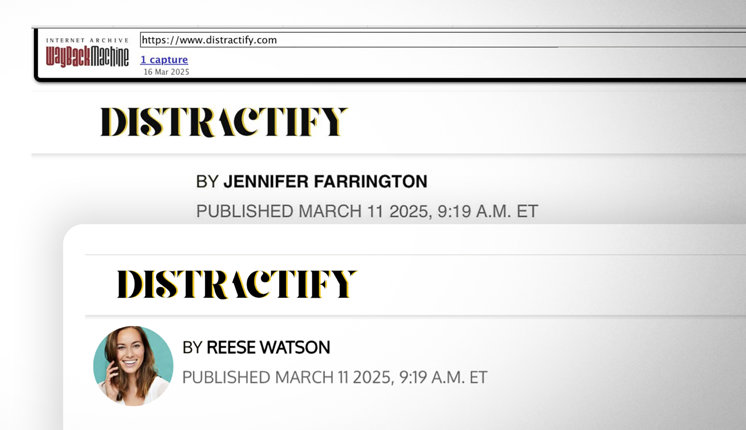These viral snippets rarely surface because friends share them. More often, they’re injected into feeds by platforms paid to manufacture visibility.
Farrington’s name was subsequently and quietly changed to “Reese Watson” when Distractify got called out.
One such company is Distractify, a digital media and entertainment website owned by Engrost, Inc. and known for producing and curating viral content, pop culture news and human interest stories, often with a tabloid spin. According to Variety, a publication that specializes in entertainment business news, Distractify competes with other viral content producers for premium placement on Facebook. Similar pay-for-visibility strategies are also common across other social media platforms and among influencers, reflecting a broader—and worrying—trend in the monetization of digital reach.
But Distractify’s questionable conduct, under the oversight of editor Carly Sitzer, doesn’t end with how it promotes its articles—it extends to how the website handles responsibility for the content itself. The site has shown no hesitation in running inflammatory pieces from freelancers, only to quietly alter (or Retractify) bylines once the author is publicly criticized.

Case in point: On March 11, Distractify published an article in which the website forwarded the blathering of a rabid anti-Scientologist, smearing the religion. It was a bigoted attack unsupported by fact, written by freelancer Jennifer Farrington.
But Farrington’s name was subsequently and quietly changed to “Reese Watson” when Distractify got called out for its hateful misinformation by STAND League, the Scientology religion’s anti-discrimination league.
The move was so absurd, it’s reminiscent of a group project gone rogue in a high school media lab. But it gets weirder—much weirder: The profile photo used for “Reese Watson” is a stock image. Download it directly from Distractify’s own site, and the file name reads “iStock” replete with barcode 1145237257-1588713982269. So “Reese Watson” isn’t just a pseudonym—it’s a phantom. A fabrication. A byline built in a content lab. And if you try emailing this so-called reporter? Your message gets routed to “editor+reese-watson@distractify.com.”
In fact, “Reese” can also be found promoting invisalign services in Orange County and dermatology in Thousand Oaks.

Now there’s a scandal worth covering: a botched byline, a fake identity and a website caught red-handed playing dress-up in the cloakroom of the attention economy. So much for Distractify’s claim of having “a zero-tolerance policy for plagiarism” and upholding “the highest of standards when it comes to transparency.”
Were we really supposed to pretend we didn’t see that Farrington’s name vanished? That we didn’t notice the digital sleight of hand? That we couldn’t spot the blindingly-white-toothed stock photo of a nonexistent reporter? How stupid do they think we are?
The real story here isn’t just a fake byline or a deceptive image—it’s a digital media company caught red-handed feigning journalistic credibility while pulling stunts not even worthy of a satire site. If there’s a moral to be learned from the fiasco, it’s that in an age where attention is currency, the only real offense is getting caught.
Freedom reached out to Carly Sitzer and Jennifer Farrington for comment. We will update the article if she or some other fake identity replies.






















